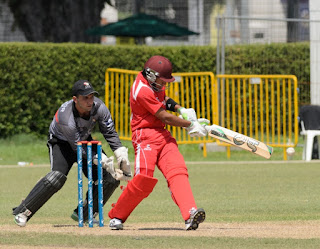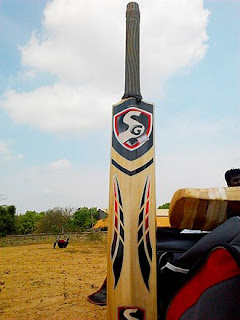WHAT IS CRICKET ??
WHAT IS CRICKET ??
Cricket is a bat-and-ball game played between two teams of eleven players on a field at the centre of which is a 20-metre (22-yard) pitch with a wicket at each end, each comprising two bails balanced on three stumps. The batting side scores runs by striking the ball bowled at the wicket with the bat, while the bowling and fielding side tries to prevent this and dismiss each player (so they are "out"). Means of dismissal include being bowled, when the ball hits the stumps and dislodges the bails, and by the fielding side catching the ball after it is hit by the bat, but before it hits the ground. When ten players have been dismissed, the innings ends and the teams swap roles. The game is adjudicated by two umpires, aided by a third umpire and match referee in international matches. They communicate with two off-field scorers who record the match's statistical information. read more
There are various formats ranging from Twenty20, played over a few hours with each team batting for a single innings of 20 overs, to Test matches, played over five days with unlimited overs and the teams each batting for two innings of unlimited length. Traditionally cricketers play in all-white kit, but in limited overs cricket they wear club or team colours. In addition to the basic kit, some players wear protective gear to prevent injury caused by the ball, which is a hard, solid spheroid made of compressed leather with a slightly raised sewn seam enclosing a cork core which is layered with tightly wound string.
Historically, cricket's origins are uncertain and the earliest definite reference is in south-east England in the middle of the 16th century. It spread globally with the expansion of the British Empire, leading to the first international matches in the second half of the 19th century. The game's governing body is the International Cricket Council (ICC), which has over 100 members, twelve of which are full members who play Test matches. The game's rules are held in a code called the Laws of Cricket which is owned and maintained by Marylebone Cricket Club (MCC) in London. The sport is followed primarily in the Indian subcontinent, Australasia, the United Kingdom, Ireland, southern Africa and the West Indies, its globalisation occurring during the expansion of the British Empire and remaining popular into the 21st century.[1] Women's cricket, which is organised and played separately, has also achieved international standard. The most successful side playing international cricket is Australia, having won seven One Day International trophies, including five World Cups, more than any other country and having been the top-rated Test side more than any other country.
The game underwent major development in the 18th century to become England's national sport.[citation needed] Its success was underwritten by the twin necessities of patronage and betting.[34] Cricket was prominent in London as early as 1707 and, in the middle years of the century, large crowds flocked to matches on the Artillery Ground in Finsbury.[citation needed] The single wicket form of the sport attracted huge crowds and wagers to match, its popularity peaking in the 1748 season.[35] Bowling underwent an evolution around 1760 when bowlers began to pitch the ball instead of rolling or skimming it towards the batsman. This caused a revolution in bat design because, to deal with the bouncing ball, it was necessary to introduce the modern straight bat in place of the old "hockey stick" shape.[36][citation needed] read more
The Hambledon Club was founded in the 1760s and, for the next twenty years until the formation of Marylebone Cricket Club (MCC) and the opening of Lord's Old Ground in 1787, Hambledon was both the game's greatest club and its focal point.[citation needed] MCC quickly became the sport's premier club and the custodian of the Laws of Cricket. New Laws introduced in the latter part of the 18th century included the three stump wicket and leg before wicket (lbw).[37] read more
The 19th century saw underarm bowling superseded by first roundarm and then overarm bowling. Both developments were controversial.[38] Organisation of the game at county level led to the creation of the county clubs, starting with Sussex in 1839.[39] In December 1889, the eight leading county clubs formed the official County Championship, which began in 1890.[40] read more
The most famous player of the 19th century was W. G. Grace, who started his long and influential career in 1865. It was especially during the career of Grace that the distinction between amateurs and professionals became blurred by the existence of players like him who were nominally amateur but, in terms of their financial gain, de facto professional. Grace himself was said to have been paid more money for playing cricket than any professional.[citation needed] read more
The last two decades before the First World War have been called the "Golden Age of cricket". It is a nostalgic name prompted by the collective sense of loss resulting from the war, but the period did produce some great players and memorable matches, especially as organised competition at county and Test level developed.[41]



Comments
Post a Comment